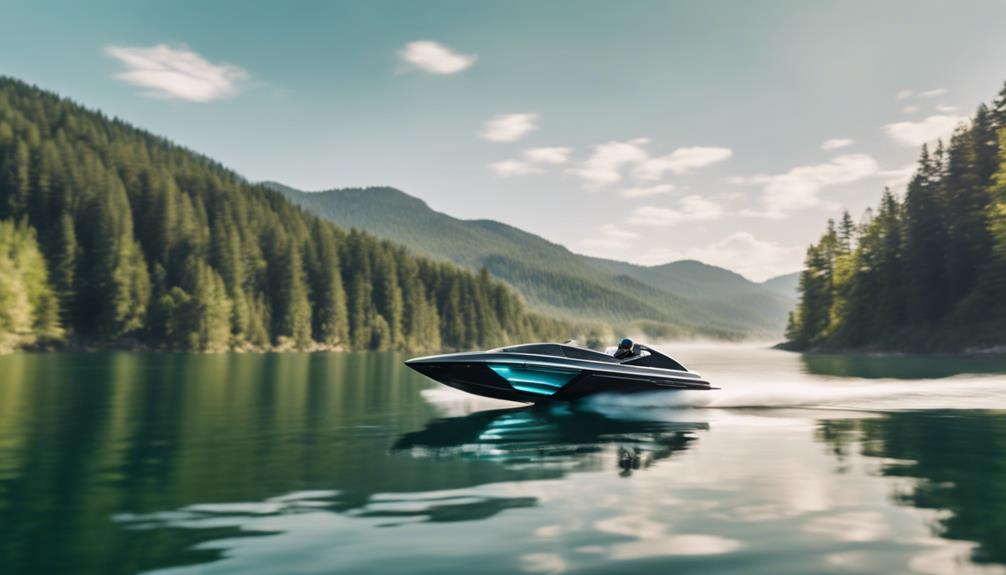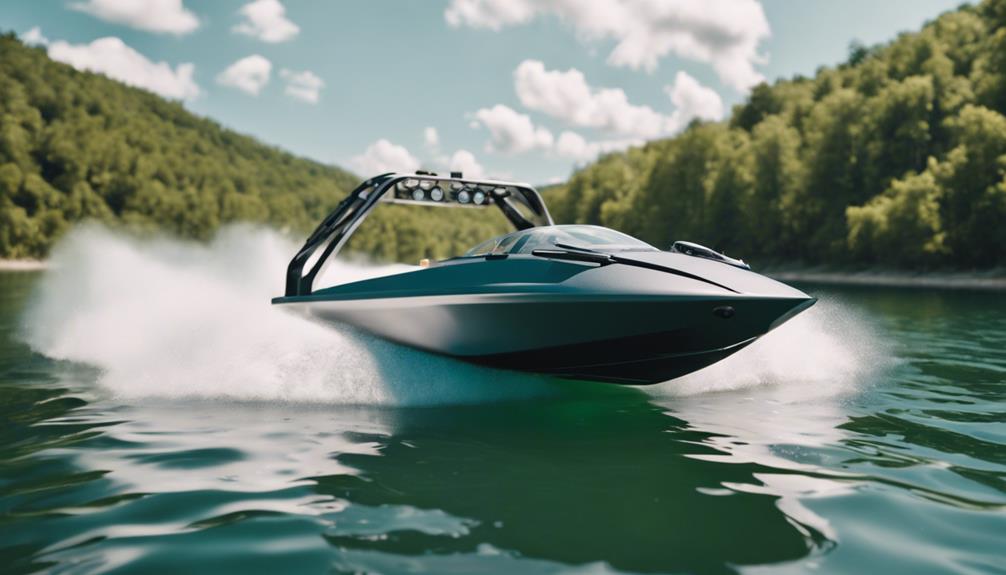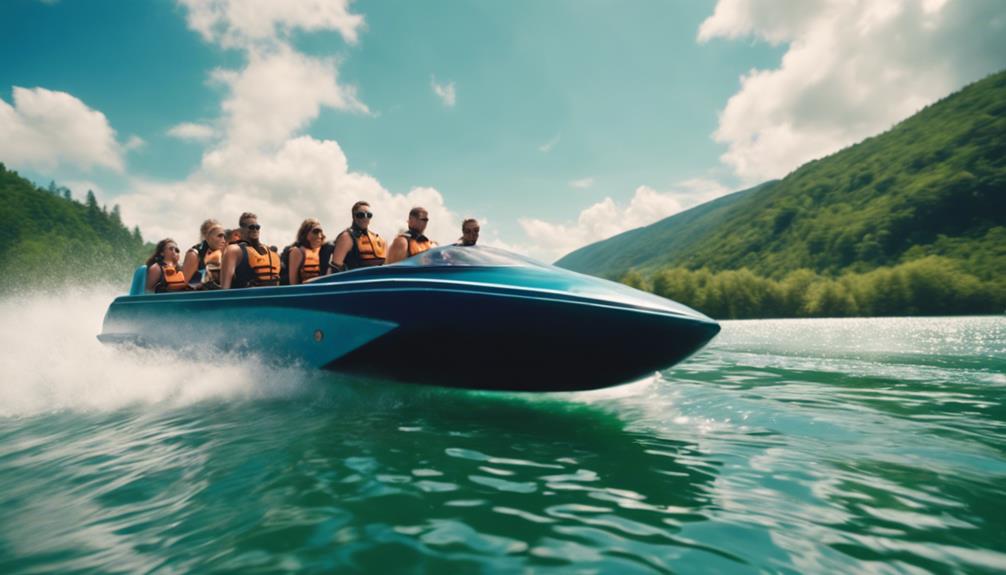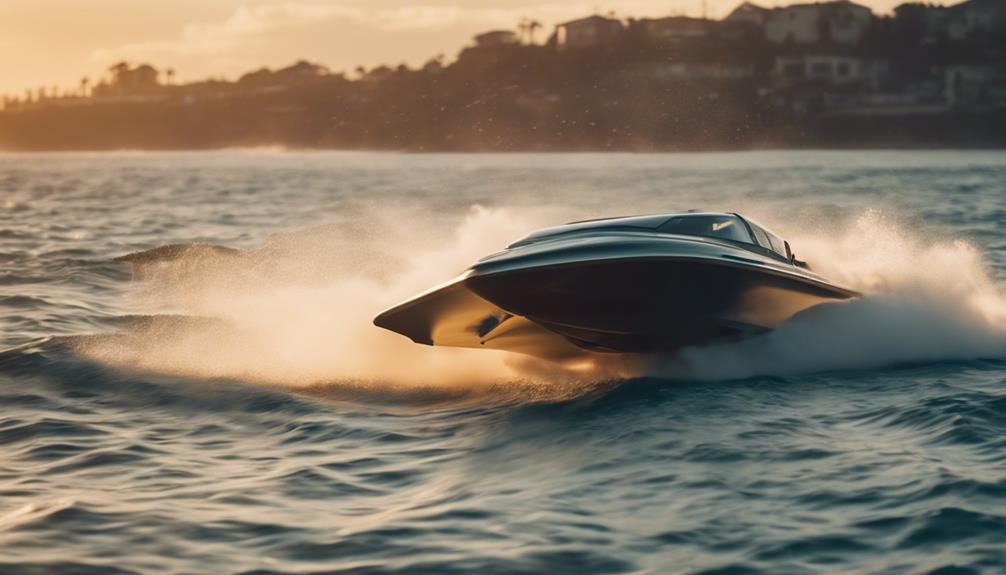Jet boats are a fantastic option if you want versatility and quick performance on the water. They excel in shallow depths, allowing you to explore areas inaccessible to other boats. With rapid acceleration and superior maneuverability, they're great for water sports and family outings. However, keep in mind that handling at low speeds can be tricky for beginners, and maintenance is a bit more demanding. While they can consume more fuel than propeller-driven boats, the unique features often outweigh the downsides. Curious about their best uses and how to choose the right one for you?
Key Takeaways
- Jet boats excel in shallow water navigation, making them ideal for accessing unique areas and rocky rivers or lakes.
- They offer quick acceleration and superior handling, enhancing safety and control in crowded environments.
- Jet boats have no exposed propellers, significantly reducing injury risks for swimmers and skiers.
- Maintenance is more demanding than inboard boats, requiring regular lubrication and thorough cleaning after each use.
Key Differences Between Jet and Inboard Boats
When you compare jet boats and inboard boats, you'll notice distinct differences in propulsion, maintenance, and suitability for various water conditions.
Jet boats use an impeller system that allows them to operate in shallow waters, often less than 6 inches deep. This capability makes them perfect for rocky rivers, where flexibility is essential. In contrast, inboard boats feature engines located within the vessel, which helps with weight distribution and stability, making them increasingly popular among river anglers.
Another key difference lies in maintenance. Jet boats require regular drive bearing lubrication and debris clearance to function effectively, while inboard boats simplify upkeep by not needing drive bearing maintenance at all. This difference can make owning an inboard boat less time-consuming overall.
When it comes to power options, jet boats offer a broader selection of manufacturers and engine sizes, ranging from 25 to 225 horsepower. Inboard boats, however, have a more limited market for engines, which can restrict your choices.
Advantages of Jet Boats

When it comes to jet boats, you'll find they excel in safety and shallow water navigation.
Their design eliminates exposed propellers, making them safer for swimmers and skiers, while their shallow draft lets you explore areas other boats can't reach.
With these advantages, jet boats truly stand out for both thrill-seekers and those looking for versatile watercraft.
Safety Features Overview
Jet boats offer impressive safety features that make them a smart choice for both recreational and fishing enthusiasts traversing various water environments. One of the standout safety aspects is the absence of exposed rotating propellers, which greatly reduces the risk of injury to swimmers and skiers. Additionally, jet boats boast a shallow draft of 12 to 17 inches, allowing you to navigate safely through shallow water while avoiding hazards.
Moreover, the quick acceleration and minimal bow-rise enhance your visibility as a captain, promoting safer navigation. Jet boats are also designed for superior handling, enabling nimble and responsive maneuvering, especially in crowded or tight spaces. This combination of features contributes to their growing popularity in various activities.
Here's a summary of the safety features you can expect:
| Safety Feature | Description | Benefits |
|---|---|---|
| No Exposed Propellers | Eliminates injury risks | Safer for swimmers/skiers |
| Shallow Draft | 12 to 17 inches | Access to shallow water |
| Quick Acceleration | Enhances visibility | Safer navigation |
| Superior Handling | Nimble maneuvering | Better control in tight spaces |
These features guarantee that jet boats are not only fun but also safe for all water activities.
Shallow Water Navigation
The impressive safety features of jet boats make them particularly suited for shallow water navigation, allowing you to explore areas where traditional boats can't venture. With their jet drive systems, these boats can operate in just 3 inches of water, giving you access to hidden gems in lakes and rivers that others can't reach.
Here are four compelling reasons to contemplate a jet boat for your next adventure:
- Incredible Flexibility: Navigate through waters as shallow as 12 to 17 inches without worry.
- Rocky River Navigation: The absence of an external propeller means you can cruise through debris-laden areas without risk.
- Speedy Maneuverability: Enjoy quick acceleration and nimble handling, perfect for narrow waterways.
- Unmatched Exploration: Discover secluded spots that traditional boats simply can't access.
Jet boats utilize an impeller system, allowing them to keep their speed even in shallow conditions.
With these advantages, you'll find that shallow water navigation becomes not only possible but exhilarating, expanding your boating horizons like never before.
Disadvantages of Jet Boats

While jet boats offer many advantages, they come with several drawbacks you should consider.
You might find handling challenges more pronounced if you're inexperienced, and the noise levels can be quite loud, especially with 2-stroke models.
Additionally, their fuel consumption may not be the most efficient, which could affect your overall boating experience.
Handling Challenges
Often, inexperienced drivers find low-speed maneuvering in jet boats challenging, especially when it comes to docking and steering through tight spaces. These handling challenges can lead to stressful situations for boat owners who aren't familiar with the unique mechanics of jet boats.
Here are some key difficulties you might face:
- Docking Dilemmas: You may struggle to position your boat accurately, resulting in frustrating attempts to dock.
- Reverse Confusion: The reverse gate mechanism can complicate backward movement, making it tough to maneuver when you need to back out of tight spots.
- Power Loss: Jumping large waves can disrupt water intake, causing momentary power loss and further complicating control.
- Drifting Issues: Older jet models might drift forward in neutral, requiring you to constantly adjust your position to maintain control.
Adapting to these handling challenges takes time and practice. If you're shifting from conventional boats, you'll likely need to recalibrate your skills, which could lead to performance variability and increased stress while on the water.
Noise Levels
Jet boats can be quite noisy, especially those equipped with two-stroke engines, making them less ideal for peaceful outings on the water. The noise levels produced by these boats can reach up to 90 decibels during operation, which is louder than many modern outboard motors. This increased noise often stems from the engine and the jet drive system, as the absence of a propeller allows sounds to carry more audibly.
If you enjoy activities like fishing or simply relaxing on the water, the loudness of a jet boat can greatly detract from your experience. While some jet boats are designed for quieter performance, many prioritize power, resulting in higher noise levels. Unfortunately, options for sound insulation are limited, which means you might be exposed to prolonged high noise levels while onboard. In some cases, this necessitates using ear protection to avoid discomfort.
Ultimately, if you're considering a jet boat, think about how the noise levels might affect your time on the water. You might find that a quieter alternative suits your needs better if you value a serene boating experience.
Fuel Consumption Issues
Fuel consumption issues can be a significant drawback of owning a jet boat, as they typically use more fuel than propeller-driven alternatives, leading to higher operational costs. You might find that while jet boats offer agility and speed, they can hit your wallet harder with fuel expenses. Here are some key points to evaluate:
- Higher Fuel Costs: Jet boats often burn more fuel, which can strain your budget over time.
- Efficiency Loss: A typical 60 hp outboard jet only delivers about 40 hp thrust, indicating a notable inefficiency.
- Low Speed Performance: When traveling at lower speeds, jet boats can waste even more fuel, making long trips costly.
- Maintenance Expenses: The need for regular cleaning and maintenance can also add to your overall fuel expenditure, impacting how much you spend on owning a jet.
Performance and Handling

When it comes to performance and handling, jet boats shine in shallow waters, effortlessly gliding through just a few inches while delivering impressive speed and agility. With the ability to operate in as little as 3 inches of water, they're perfect for maneuvering rocky rivers and lakes. You'll enjoy superior acceleration and turning capabilities compared to similar-sized pleasure boats, with some models reaching speeds up to 55 mph, depending on the engine setup.
The absence of a traditional propeller means jet boats have a shallow draft and reduced drag, which enhances overall performance and maneuverability. However, keep in mind that low-speed handling can be tricky for inexperienced drivers. The smaller steering nozzles can complicate tight maneuvers, so practice is essential.
To truly master the unique handling characteristics of jet boats, you'll need to hone your skills, especially when executing power stop U-turns or maneuvering choppy waters. With time and experience, you'll find that the performance and handling of jet boats can provide an exhilarating experience on the water. Just be prepared to invest some time into learning the ropes!
Maintenance Requirements

Maintaining a jet boat involves regular tasks to guarantee peak performance and longevity. You'll want to stay on top of the maintenance requirements to keep your water adventures smooth and enjoyable. Here are some essential tasks you shouldn't overlook:
- Lubricate the drive bearing every 10 hours and purge every 30-40 hours to confirm ideal performance.
- Inspect the impeller and reverse gate functionality regularly, as this is critical for smooth operation.
- Clean your jet boat thoroughly after each use to prevent debris from clogging the jet system, which can greatly affect performance.
- Clear the intake grates periodically to avoid performance issues caused by debris accumulation.
The good news is that maintenance access is generally easier in jet boats due to the tilt-trimmed engines, allowing for quick grate access.
Price Range and Value

Understanding the price range and value of jet boats is important, especially after considering the maintenance requirements that can affect your overall investment. Jet boat prices typically vary from $4,500 to $15,000, depending on factors like size and engine power.
Smaller models tend to be more budget-friendly, making them attractive if you're looking to save some cash. However, if you're eyeing higher horsepower options, be prepared for prices that can rival those of inboard boats, especially among premium brands.
For instance, a 27-foot twin-engine cruising jet boat can set you back around $140,000, indicating that larger models require a significant investment.
When evaluating your options, remember that pricing is influenced by engine size, overall specifications, and market demand. This means that while you can find affordable boats, the features you want may push the price higher.
Ultimately, understanding the price range and value of these boats is essential in making an informed decision that aligns with your budget and boating needs.
Best Uses for Jet Boats

Jet boats shine in a variety of settings, making them perfect for family outings, water sports, and fishing adventures. Their versatility allows you to enjoy memorable experiences on the water, whether you're with friends or family. Here are some of the best uses for jet boats:
- Family Outings: With plenty of space for everyone, you can create lasting memories on the water, whether you're picnicking on a secluded beach or exploring scenic lakes.
- Water Sports: Jet boats offer quick acceleration and sporty performance, making them ideal for thrilling activities like wakeboarding, tubing, or waterskiing.
- Fishing Adventures: Fishing enthusiasts appreciate jet boats for their shallow water capability, allowing you to reach otherwise inaccessible spots. Models like the Yamaha 190 FSH even cater specifically to anglers.
- Social Gatherings: They accommodate larger groups easily, so you can host fun day trips with friends, enjoying the sun and water together.
Safety Features to Consider

When choosing a jet boat, you should prioritize safety features that protect both passengers and those in the water. Unlike traditional boats, jet boats have no exposed rotating propellers, which greatly reduces the risk of injury for swimmers or skiers nearby.
To guarantee a safe experience, equip your jet boat with essential safety gear and consider the following features:
| Safety Feature | Importance | Required Gear |
|---|---|---|
| No Exposed Propellers | Reduces injury risk | – |
| Life Jackets | Essential for all passengers | Must be readily accessible |
| Fire Extinguishers | Critical for emergencies | At least one on board |
| Navigation Lights | Enhances visibility during low-light use | Required for night use |
| Sound Signaling Devices | Facilitates communication in crowded areas | Necessary for safety |
Having adequate storage for this essential safety gear is crucial. This way, you'll guarantee that everything is easily accessible in case of an emergency. By considering these safety features, you can enjoy your jet boating adventures with peace of mind.
Making the Right Choice

Choosing the right jet boat requires careful consideration of factors like local water conditions, intended use, and your own experience level. Here are some key points you need to know:
- Water Depth: Jet boats can operate in as little as 3 inches of water, making them ideal for shallow areas. Confirm your local waters are suitable.
- Intended Use: Are you looking for a boat for recreation, fishing, or thrilling water sports? This will dictate the model and features that best suit you.
- Experience Level: If you're new to boating, recognize that jet boats have unique handling characteristics. You may need some practice to maneuver effectively, especially in tight spaces.
- Budget: Jet boats range from $4,500 to $15,000. Don't forget to factor in maintenance, insurance, and fuel costs when setting your budget.
Frequently Asked Questions
What Are the Downsides of Jet Boats?
When considering jet boats, you might face challenges like reduced horsepower when slowing down, tricky low-speed handling, louder operation, and potential debris damage. Regular maintenance is essential to keep your jet boat performing at its best.
Are Jet Boats Good in Rough Water?
Steering rough water in a jet boat's like trying to dance on a tightrope. You'll struggle with control and stability, especially at low speeds, making it challenging for inexperienced drivers to maneuver effectively.
What Are the Risks of Jet Boats?
When considering jet boats, you'll face risks like engine damage from debris, potential control loss when jumping waves, drifting in neutral, and handling challenges at low speeds, especially if you're inexperienced. Noise levels can be an issue too.
What Are Jet Boats Good For?
You might think jet boats are just for speed demons, but they're perfect for shallow waters, fishing, or family outings. With quick acceleration and safety features, they blend fun and practicality seamlessly on the water.
What Are the Advantages of Jet Boats Compared to Prop Boats?
When it comes to the ultimate comparison jet vs prop, jet boats have several advantages over prop boats. Jet boats are known for their shallow draft, making them ideal for navigating shallow waters. Additionally, jet boats are safer for water sports enthusiasts due to their lack of exposed propellers, reducing the risk of accidents.
Conclusion
In the end, jet boats can be a fantastic choice if you're looking for speed and maneuverability.
They've got their pros and cons, but with the right research, you can find one that fits your needs like a glove.
Whether you're cruising on a lake or tackling shallow rivers, just remember to weigh your options and consider maintenance and safety features.
With a little effort, you'll be making waves in no time!










